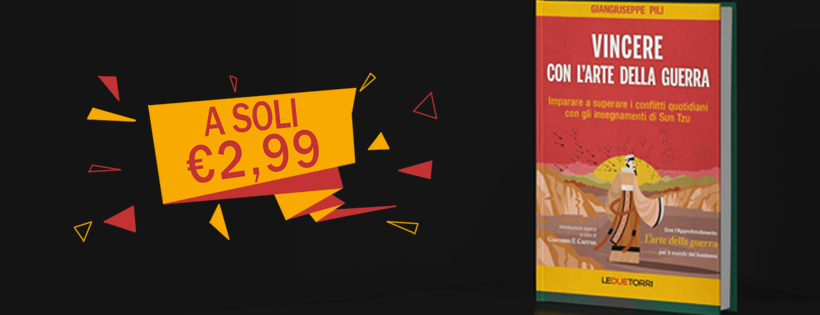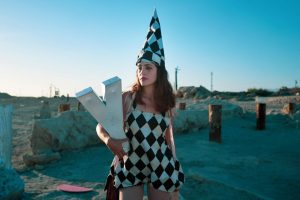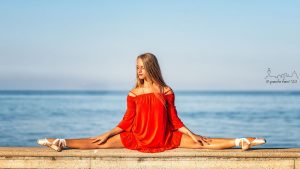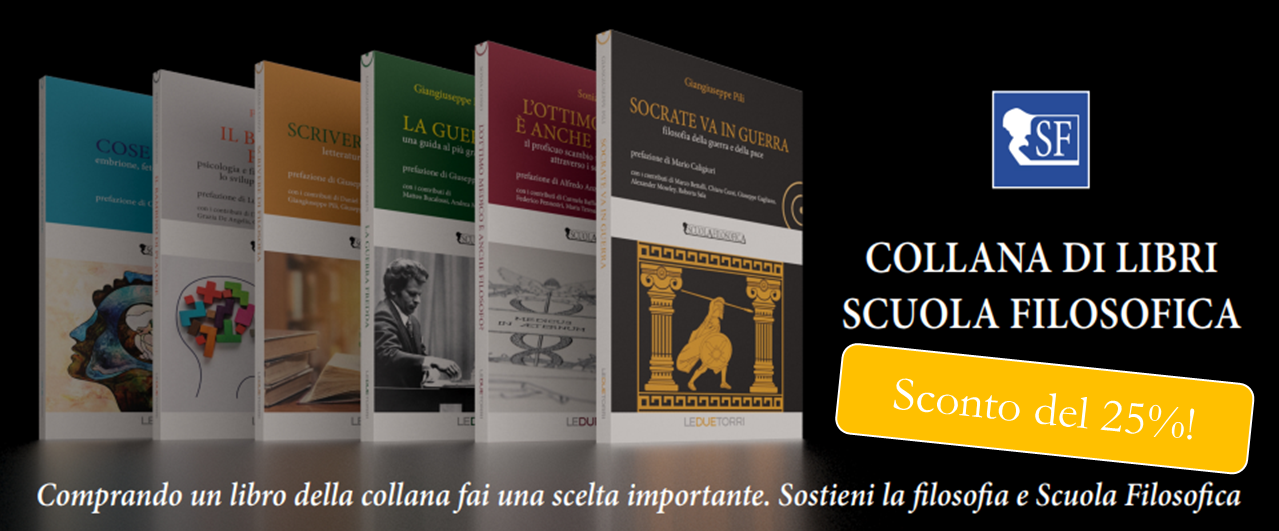Per Sonja Smolec, liricamente una rara perla sul palmo della mano anticiperebbe l’abbraccio, mentre il cuore sarebbe una conchiglia rosa, avente le doghe come una panchina coperta da un lillà (col blu “zuccherato” delle onde, fra le foglie). Nel complesso conterebbe l’estasi della germogliazione, per simboleggiare l’amore umano. Giulia ha posato al piano americano, presumibilmente ballando in una discoteca. Lei porta un abito trasparente, che noi percepiamo in lustrini finissimi, e per una tonalità più lilla che argentea. Dietro al corpo, c’è il parapetto d’una scaletta. Pure questo ha la trasparenza: del vetro o comunque plastificata. Noi immaginiamo che gli orecchini “a campanella” dettino un tempo estatico alle luci psichedeliche, e sui “tasti” per le vene “a flauto” (scorrendo tramite le sottili bretelle). Se la musica fosse ondeggiante, allora l’ancheggiamento di Giulia si renderebbe galleggiante, estaticamente.
According to Sonja Smolec, lyrically a rare pearl in the palm of the hand would anticipate the embrace, while the heart would be a pink shell, having the slats like a bench covered by a lilac (with the “sugared” blue of the waves, between the leaves). Overall the ecstasy of the sprouting would be important, to symbolize the human love. Giulia posed in a cow-boy shot, presumably dancing at the disco. She has a transparent dress, that we perceive with very fine sequins, and for a tone more lilac than silver. Behind the body, there is the parapet of a stair set. Also this element has the transparency: of the glass or however plasticized. We imagine that the earrings “in a small bell” dictate an ecstatic tempo to the psychedelic lights, and on the “keys” for the veins “as flutes” (flowing through the thin straps). If the music was undulating, so the swing of the hips in Giulia would become floating, aesthetically.
(courtesy to Giulia Radin)
Interpretando Romano Battaglia, bisognerebbe che noi sorridessimo al nostro destino, avendo vissuto in un carnevale di maschere toglibili, se l’illusione sarà stata capace di danzare fino al punto da captare, una volta per tutte, la fiducia di qualcuno (e per l’amore reciproco). La regista Susanna appare inquadrata in una delle sue sinergie di lavoro. Lei posa da figurante carnevalesco, indossando i rombi bianconeri. Susanna ci spiega d’aver scritturato una ballerina meccanicamente perfetta, a tal punto da non arrendersi al suo abbandono fra gli scarti. Il progetto s’intitola Wasteplanet, ed è ambientato nel villaggio di Bombay Beach, negli USA, dove una comunità di artisti s’autogestisce amorevolmente, da anni. Contro la produzione industriale (la quale cede nell’accettare e favorire il consumismo), l’estetica rivendicherà la propria aura (da Walter Benjamin). Addirittura il deserto (intorno a Bombay Beach) avrà favorevolmente il miraggio “risorto” sul ricetrasmettitore (necessario per uscire dall’isolamento), grazie al cappello a cono, mentre il vicino lago (il Salton Sea) potrà depurarsi dai veleni, “elasticizzandosi” con la danza d’un atollo (dal modulo a ˂ lettera Y ˃ che Susanna regge, sul braccio destro). Peraltro qui l’espressione del viso si percepisce seria, e chissà se con una vena di malinconia… L’arte è destinata a lottare continuamente contro la mercificazione!
Commenting Romano Battaglia, we should smile at our destiny, after we lived in a Carnival of removable masks, if the illusion would have been able to dance to the point of the interception of someone’s trust, once for all (and for the mutual love). Director Susanna appears framed in one of her work synergies. She poses as a carnivalesque figurant, wearing the black and white rhombi. Susanna explains to us that she cast a dancer mechanically perfect, to the point that this one did not give up to the own abandonment between the scrap. The project is called Wasteplanet; and it is set in Bombay City, in the USA, where a community of artists lives in self-management, lovingly for years. Against the industrial production (which cedes to the approval and the abetment of the consumerism), the aesthetics will claim the own aura (from Walter Benjamin). Even the desert (around Bombay City) will positively have the mirage “resuscitated” on the transmitter receiver (necessary to get out of an isolation), through the cone hat, while the near lake (the Salton Sea) could be purged of the poisons, “elasticizing itself” with the dance of an atoll (from the module as ˂ letter Y ˃ that Susanna holds, on the right arm). However here the face’s expression is perceived as serious, and who knows if it has a vein of melancholy… The art is destined to fight continually against the commodification!
(courtesy to Susanna Della Sala)
Per David Harsent, liricamente un guanto od una coccarda in platea avranno “tamponato” la risacca col suo ticchettio sulle barche. Nel complesso, si dovrà celebrare l’eleganza dei momenti mancati. Forse, se l’azione comporta sempre la reazione, allora si maturerà accettando il ˂ ci abbiamo provato ˃. Nicole posa da danzatrice, con le gambe aperte e distese, in spaccata. Lei è seduta sul muretto d’un lungomare. L’abito in rosso si percepisce raccolto “a coccarda”, dalle spalle alle cosce. Sullo sfondo, il mare è al fuori fuoco. Si può immaginare che in questo caso la danza sopperisca al nuoto, preservandovi comunque la floridezza. Ma quanto le scarpe consentiranno il tip-tap alle onde, a parità di bianchezza? Esisterebbe una danzatrice sul mare: la sirena.
According to David Harsent, lyrically a glove or a cockade in the stalls would have “buffered” the undertow with its ticking against the boats. Overall, we will have to celebrate the elegance of the missing moments. Perhaps, if the action always entails a reaction, so we will mature accepting the ˂ we tried ˃. Nicole poses as a dancer, with the legs opened and stretched, doing the splits. She is seated on the small wall of the seafront. The red dress is perceived gathering “a cockade”, from the shoulders to the thighs. On the background, the sea is out of focus. We can imagine that in this case the dance compensates for the swimming, preserving there however the flourishing. But how much will the shoes allow a tap dance for the waves, with equal whiteness? A dancer on the sea would exist: the siren.
(courtesy to Paolo Fani)
Bibliografia – Bibliography
BATTAGLIA R., Silenzio, Rizzoli, Milano 2005
HARSENT D., Selected poems: 1969-2005, Faber & Faber, Londra 2007
SMOLEC S., Nacreous verse, Lulu, Raleigh 2010, p. 36
Biografia – Biography
La modella italiana Giulia Radin viene da Padova, e ha studiato Sicurezza igienico-sanitaria degli alimenti. Lei non ricorda il nome del suo fotografo.
The Italian model Giulia Radin comes from Padua, and studied Food safety and security. She does not remember the name of her photographer.
L’artista, regista e modella italiana Susanna Della Sala nasce a Pavia nel 1987. Lei ha studiato sia al Politecnico di Milano, sia al Centro Sperimentale di Cinematografia a Roma. La notorietà internazionale di Susanna è avvenuta grazie al suo documentario Last stop before Chocolate Mountain. Lei ha avuto la supervisione di questo scatto.
The artist, director and model Susanna Della Sala was born in Pavia (Italy) in 1987. She studied both at the Polytechnic University of Milan, and at the Experimental Center of Cinematography in Rome. The international notoriety of Susanna has happened through her short film Last stop before Chocolate Mountain. She had the supervision over this shot.
www.susannadellasala.com
La modella italiana Nicole Ninci viene da Campiglia Marittima (Livorno). Lei è appassionata di filosofia.
The Italian model Nicole Ninci comes from Campiglia Marittima (Province of Livorno). She is fond of philosophy.
Il fotografo italiano Paolo Fani vive a Firenze. Esteticamente, scattando a lui interessa trovare la verità e la bellezza.
The Italian photographer Paolo Fani lives in Florence. Aesthetically, in his shots he is interested in finding the truth and the beauty.
www.paolofani.it







Be First to Comment